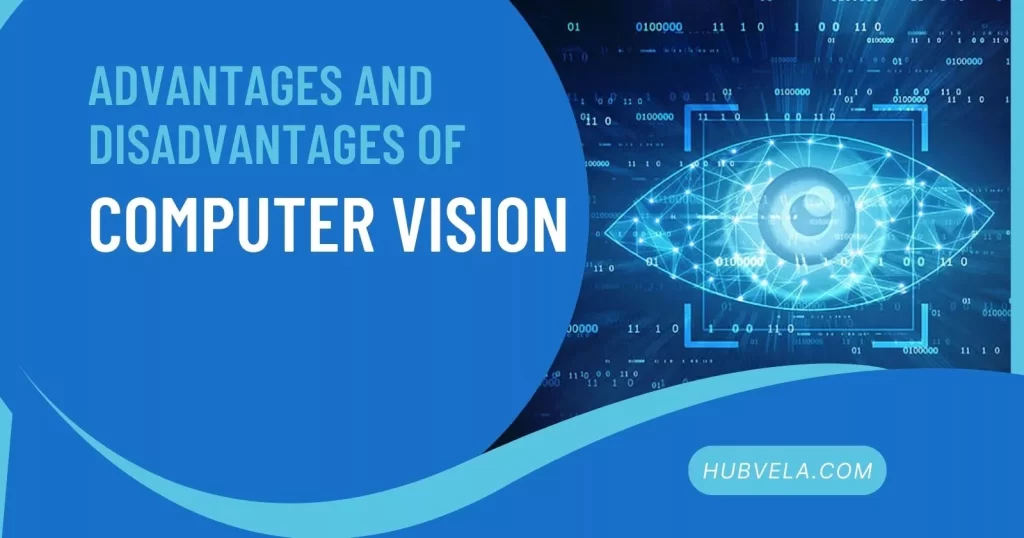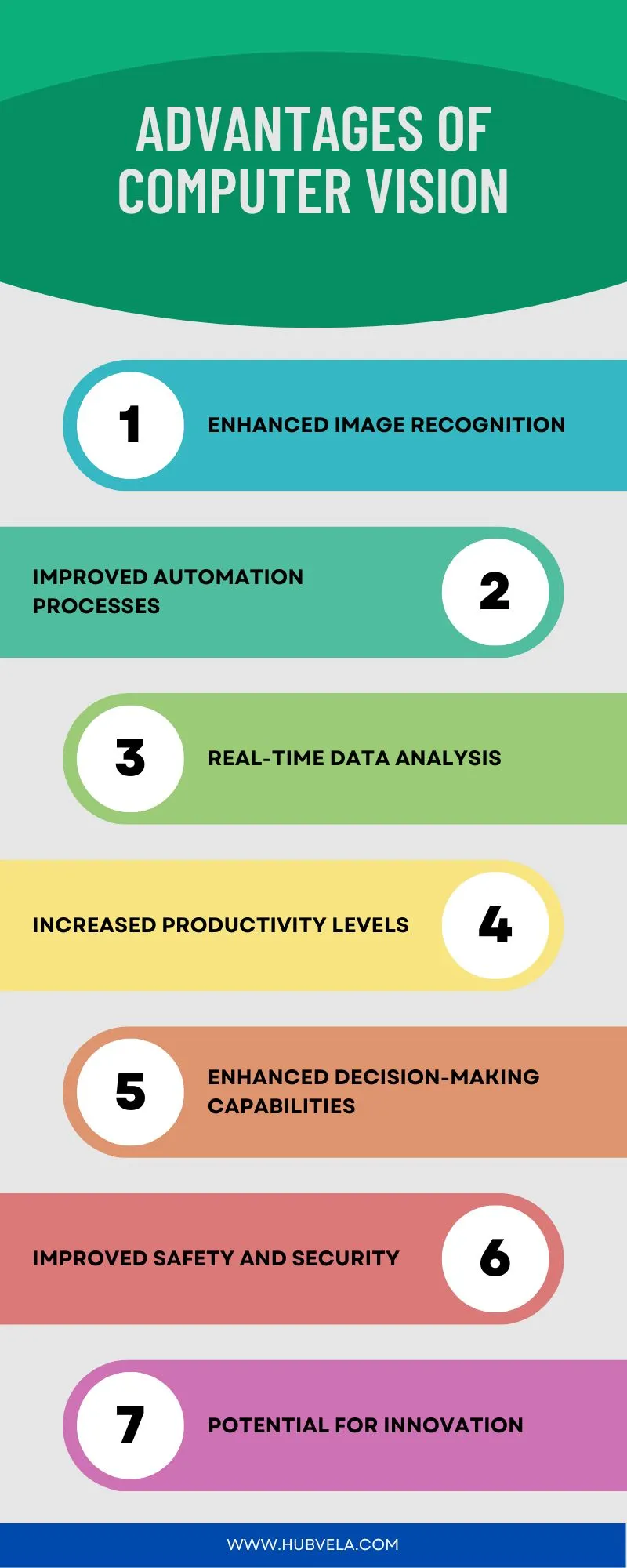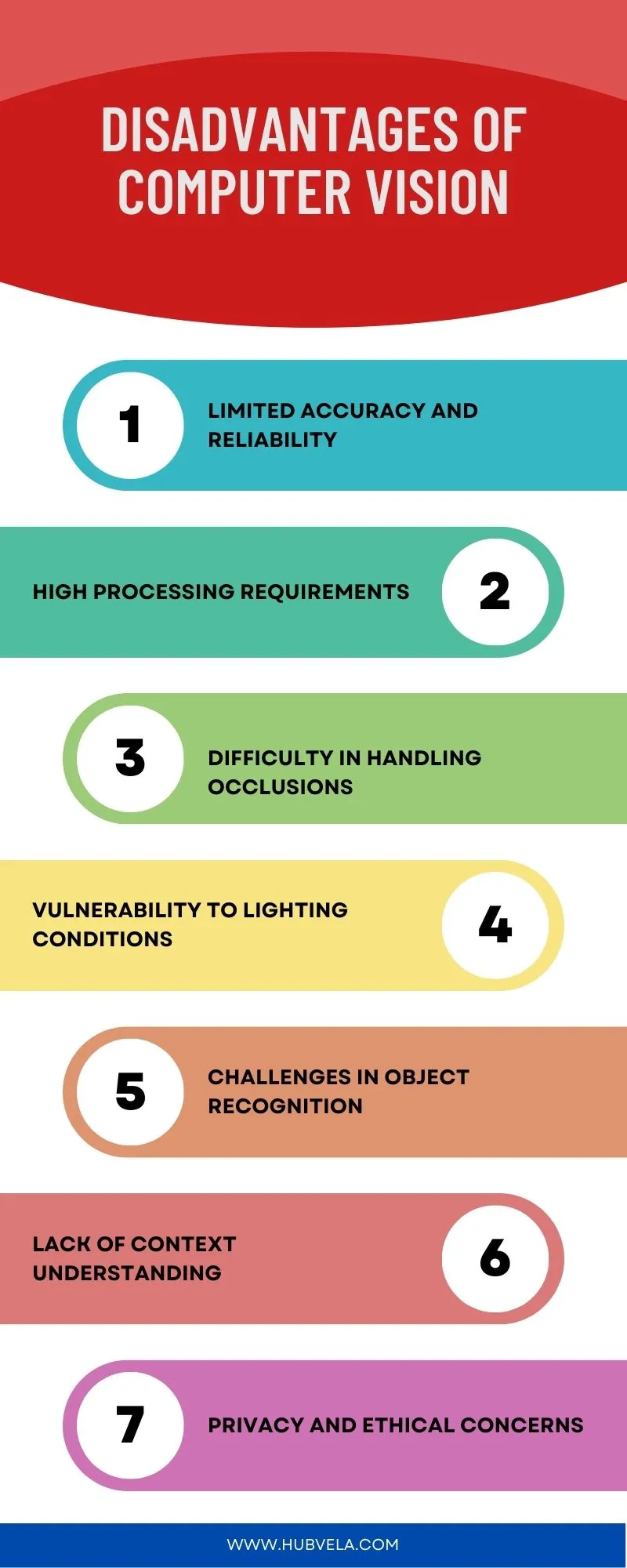Have you ever wondered how self-driving cars are able to navigate through busy streets without a human driver? It’s all thanks to computer vision!
Computer vision is the field of artificial intelligence that allows computers to understand and interpret visual information from images or videos.
In this article, we will explore the advantages and disadvantages of computer vision. By harnessing the power of computer vision, industries such as healthcare, transportation, and security can benefit from improved efficiency, accuracy, and safety.
However, like any technology, there are also challenges to consider, such as privacy concerns and potential biases.
So, let’s dive into the world of computer vision and explore its pros and cons!

--Advertisement--
What is Computer Vision?
Computer Vision is the process of enabling computers to perceive and understand visual information through the use of algorithms and machine learning techniques.
It has a wide range of applications, including object recognition, image classification, video surveillance, augmented reality, and autonomous vehicles.
The key components of computer vision include image acquisition, preprocessing, feature extraction, and pattern recognition.
Machine learning plays a crucial role in computer vision by training algorithms to recognize and interpret visual data.
However, there are several challenges in computer vision research, such as dealing with occlusion, variability in lighting conditions, and complex scene understanding.
Despite these challenges, the future of computer vision technology looks promising, with advancements in deep learning, neural networks, and data processing capabilities, which will further enhance its applications and capabilities.
Advantages of Computer Vision
Computer vision, a field of artificial intelligence, enables computers to process, analyze, and understand visual data from the world around them, such as images and videos.
It has numerous benefits across various industries. Some of the key advantages of computer vision include:

1. Enhanced Image Recognition
Have you ever wondered how computers are able to recognize images with such accuracy and speed?
The answer lies in the advancements in image processing, pattern recognition, machine learning, deep learning, and computer algorithms.
Enhanced image recognition is one of the significant advantages of computer vision. Through image processing techniques, computers can analyze and manipulate images to extract valuable information.
Pattern recognition algorithms enable computers to identify and classify objects, even in complex scenes.
Machine learning and deep learning algorithms further enhance image recognition capabilities by allowing computers to learn from large datasets and improve their accuracy over time.
With the help of computer vision, industries such as healthcare, automotive, and security can benefit from improved image recognition systems that aid in diagnostics, autonomous driving, and surveillance.
2. Improved Automation Processes
Enhanced image recognition in computer vision enables you to automate various processes with greater efficiency and accuracy. This improved automation brings a range of benefits.
Firstly, it leads to efficiency improvements by reducing the time taken to complete tasks. With computers able to analyze and process images quickly, repetitive tasks can be completed at a much faster rate.
Secondly, automation brings cost savings as it reduces the need for human labor. By replacing manual work with computer vision systems, companies can cut down on labor costs. Additionally, automation reduces human error, which can be costly in industries where precision is crucial.
Finally, computer vision allows for increased scalability, as systems can be easily replicated and deployed across different locations or processes.
3. Real-Time Data Analysis
One advantage of computer vision is the ability to analyze real-time data with greater efficiency and accuracy. With real-time analytics, you can gather and process data as it’s generated, enabling you to make timely and informed decisions.
Computer vision algorithms can provide predictive insights by analyzing patterns and trends in the data, helping you anticipate future outcomes. These algorithms can also utilize data visualization techniques to present complex information in a visually intuitive format, making it easier for you to understand and interpret the data.
Additionally, computer vision enables pattern recognition, allowing you to identify and analyze recurring patterns in the data, which can uncover valuable insights.
4. Increased Productivity Levels
Improve your productivity levels with computer vision technology.
By harnessing the power of computer vision, businesses can experience increased efficiency and streamlined operations.
With advanced analytics provided by computer vision systems, companies can gain valuable insights into their processes and make more informed decisions.
This technology allows for real-time monitoring and analysis, enabling businesses to identify bottlenecks and implement improvements quickly.
By automating tasks that were previously done manually, computer vision technology saves time and reduces errors, resulting in significant cost savings.
Moreover, computer vision systems can handle repetitive tasks with precision and accuracy, freeing up human resources to focus on more complex and strategic activities.
5. Enhanced Decision-Making Capabilities
With computer vision technology, you can enhance your decision-making capabilities. By utilizing advanced algorithms and machine learning, computers can analyze vast amounts of data and provide valuable insights for decision making. This ability to process and interpret data quickly and accurately can greatly improve productivity levels.
With the assistance of computer vision, you can make informed decisions based on real-time information, leading to more efficient and effective outcomes. Moreover, computer vision can contribute to safety and security by identifying potential risks and hazards in various environments. By detecting anomalies and monitoring activities, computer vision technology enhances the overall safety measures.
Furthermore, the potential for innovation is vast with the integration of computer vision. It opens up opportunities for creative solutions and advancements in various fields, leading to improved decision making capabilities.
6. Improved Safety and Security
Computer vision technology enhances safety and security by providing real-time monitoring and detection of potential risks and hazards.
With improved surveillance capabilities, computer vision systems can constantly monitor a wide area, detecting any suspicious activities or unauthorized access.
Facial recognition technology allows for the identification and tracking of individuals, helping to prevent crimes and ensure the safety of people in public spaces.
Additionally, object detection algorithms can quickly identify dangerous objects or potential threats, enabling timely intervention and prevention.
Computer vision also plays a crucial role in fraud prevention by analyzing patterns and anomalies in financial transactions, reducing the risk of fraudulent activities.
7. Potential for Innovation
One advantage of computer vision technology is its potential for driving innovation in various industries. With its ability to analyze visual data and extract meaningful information, computer vision opens up a plethora of potential applications.
By integrating with artificial intelligence (AI), computer vision can enhance the capabilities of AI systems, enabling them to understand and interact with the visual world. In healthcare, computer vision can revolutionize diagnostics and treatment by automating tasks such as medical imaging analysis.
Furthermore, advancements in robotics can be greatly accelerated with the integration of computer vision, allowing robots to perceive and interact with their environment more effectively.
However, the potential for innovation also comes with ethical implications. Issues such as privacy, bias, and accountability need to be carefully addressed to ensure the responsible and ethical use of computer vision technology.
Disadvantages of Computer Vision
Computer vision is a powerful technology that has the potential to revolutionize various industries and applications, such as healthcare, gaming, and security.
However, despite its numerous advantages, there are also some disadvantages associated with computer vision systems. We will discuss the key disadvantages of computer vision, including:

1. Limited Accuracy and Reliability
You may experience limited accuracy and reliability with computer vision.
While computer vision technology offers numerous benefits and potential applications, there are challenges in its implementation that can affect its accuracy and reliability.
One of the main drawbacks is the limited accuracy of computer vision systems in certain scenarios. Factors such as lighting conditions, occlusions, and variations in object appearances can affect the accuracy of the system’s recognition and detection capabilities.
Additionally, the reliability of computer vision systems can be compromised by false positives and false negatives, leading to errors in decision-making processes.
These limitations can be particularly problematic in critical applications, such as autonomous vehicles or medical diagnosis.
Therefore, it’s important to carefully consider the potential drawbacks and limitations of computer vision technology before relying on it for tasks that require high levels of accuracy and reliability.
2. High Processing Requirements
To address the high processing requirements of computer vision, it’s important to carefully consider the computational resources needed for efficient and accurate image analysis.
Computer vision tasks, such as object recognition and image segmentation, can be computationally complex and resource-intensive. The hardware requirements for computer vision systems can be demanding, as they often involve powerful processors and large amounts of memory.
Additionally, the data processing involved in computer vision applications can be time-consuming and require significant processing power. These performance limitations can pose challenges for real-time applications or systems that require quick decision-making.
Therefore, it’s crucial to optimize algorithms and utilize hardware acceleration techniques to mitigate the high processing requirements of computer vision and ensure efficient and effective image analysis.
3. Difficulty in Handling Occlusions
How can computer vision systems effectively handle occlusions?
Handling occlusions is one of the major challenges in computer vision. Occlusions occur when objects in a scene are partially or completely hidden by other objects. Detecting and managing occlusions is crucial for accurate object recognition and tracking.
Occlusion detection involves identifying the areas where occlusions occur and understanding the relationships between occluded and occluding objects.
Occlusion management requires finding solutions to handle occlusions, such as predicting the occluded parts of objects based on their appearance or utilizing data from multiple sensors to reconstruct the complete scene.
These solutions enable computer vision systems to adapt and make accurate interpretations even in the presence of occlusions, improving their overall performance and reliability.
4. Vulnerability to Lighting Conditions
One major disadvantage of computer vision is its vulnerability to various lighting conditions. The limitations of computer vision systems become apparent when they’re exposed to different lighting environments. Changes in lighting can have a significant impact on the performance and accuracy of computer vision algorithms.
Challenges arise when the system struggles to distinguish objects or recognize patterns due to poor lighting conditions. To overcome this issue, researchers have been working on developing solutions such as adaptive algorithms that can adjust the image processing techniques based on the lighting conditions.
Additionally, advancements in sensor technology, such as the development of low-light sensors and infrared cameras, offer promising future developments to enhance computer vision systems’ ability to handle various lighting conditions.
5. Challenges in Object Recognition
You may encounter challenges in object recognition with computer vision systems, as they may struggle to accurately identify and categorize objects. One of the main challenges is in deep learning, where the complexity and variability of objects can cause difficulties in training accurate models.
Object detection techniques, such as Faster R-CNN and YOLO, try to address this challenge by identifying and localizing objects within an image. However, these techniques can still face issues with occlusion and scale variation.
Another challenge lies in image segmentation methods, which aim to classify and segment objects within an image. These methods often require extensive computational resources and can be time-consuming.
Additionally, feature extraction algorithms and image classification models may encounter challenges in accurately representing and classifying objects with high levels of similarity or ambiguity.
6. Lack of Context Understanding
Computer vision systems can struggle to fully understand the context of a given image, leading to limitations in their ability to accurately interpret and analyze visual information. This lack of context understanding arises from the complexity of visual perception and the challenges involved in image processing.
While machine learning algorithms, such as deep learning, have made significant advancements in object recognition, they often fail to incorporate contextual information effectively. Context understanding requires a deeper level of comprehension, where the system can infer relationships between objects, recognize spatial arrangements, and understand the overall scene.
Without this contextual understanding, computer vision systems may misinterpret or misclassify objects, leading to inaccurate analysis and decision-making. Therefore, researchers are actively exploring ways to improve context understanding in computer vision, aiming to enhance the system’s ability to interpret visual information accurately.
7. Privacy and Ethical Concerns
Continuing from the previous subtopic, it is crucial to address the privacy and ethical concerns associated with computer vision systems.
One of the major concerns is data protection. Computer vision systems collect and process vast amounts of personal data, raising questions about how this data is stored and used.
Ethical implications also arise, as these systems have the potential to infringe on individuals’ privacy rights. Surveillance concerns are another issue, as computer vision can be used for constant monitoring and tracking of individuals, leading to a loss of personal freedom.
Bias in algorithms is yet another concern, as computer vision systems can perpetuate discriminatory practices if the algorithms aren’t properly designed and tested.
To address these concerns, regulation, and legislation are necessary to ensure that computer vision is used responsibly and ethically.
Conclusion on Advantages and Disadvantages of Computer Vision
In conclusion, computer vision offers numerous advantages that can greatly benefit various industries and processes. Enhanced image recognition allows for more accurate identification and analysis of visual data, while improved automation processes streamline repetitive tasks and increase efficiency.
Real-time data analysis enables organizations to make informed decisions based on up-to-date information, leading to increased productivity levels.
Additionally, computer vision enhances decision-making capabilities by providing valuable insights and patterns from visual data.
Furthermore, computer vision has the potential to revolutionize safety and security measures by enabling the detection of potential threats and monitoring of critical areas.
It also opens up possibilities for innovation, as new applications and technologies can be developed to harness the power of visual data.
However, it is important to acknowledge the disadvantages of computer vision. Limited accuracy and reliability can hinder the effectiveness of the technology, and high processing requirements may impose significant costs and infrastructure constraints.
Challenges such as handling occlusions, variations in lighting conditions, and object recognition can also impact the performance of computer vision systems.
Moreover, the lack of context understanding and the potential for privacy and ethical concerns raise important considerations for the widespread adoption of this technology.
By understanding and addressing these challenges, computer vision can continue to evolve and contribute to advancements in various industries, ultimately improving our lives in numerous ways.


